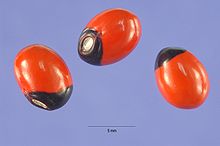Rati
Rati , also called Ruttee , Rutti or Retty , was an Indian measure of weight that was based on the weight of the paternoster pea . It was also called Gunja or Surch . In the 19th century the measure was valid in Bombay and in Surate during the Bombay presidency . As a gemstone weight under Pakka-Retty in Bengal , it was 7/40 grams or 0.175 grams in decimal. It was also used as a gold and silver weight in various regions in East Asia .
The gold and silver weights were different and it counted in
- Bombay and Surate
- 1 retty = ⅛ grams
- 3 Retty = 1 Waal / Vall
- 95 Retty = 1 tola
- 22 Anna = 1 Reddy
- 13.75 Chouw = 1 Reddy
- Bengal
- 1 retty = 4 nely = 1/7 gram
- 8 rettys = 1 massa
- 72 rettys = 1 tola gold
- 84 Rettys = 1 tola silver
Other dimensions were Tola-Pakka and Tola Katja.
literature
- Friedrich Krüger : Complete manual of the coins, measures and weights of all countries in the world. Verlag Gottfried Basse, Quedlinburg / Leipzig 1830, p. 273
Individual evidence
- ^ Johann Christian Nelkenbrecher: Nelkenbrecher's pocket book of coin, measure and weight for merchants. Arnold Wever, Berlin 1793, p. 345
